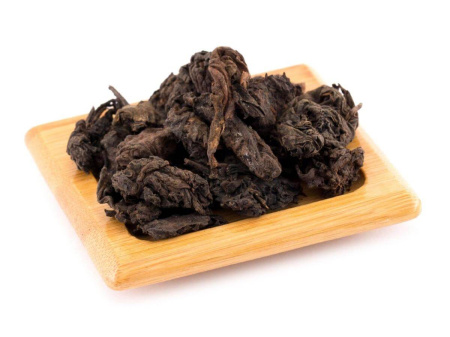Chinese Shu Pu'er tea 2016 "Jingdong Laochatou" (老茶头, Lǎo chá tóu, "Old tea heads from Jingdong")
Shu Pu'er "Jingdong Laochatou" is a unique and rare type of Chinese tea, which is valued for its richness, depth of taste and unusual shape. "Laochatou", or "old tea heads", are dense lumps of tea leaves that are formed during the fermentation of Shu Pu'er. The raw materials for this tea were produced in 2016 in the Jingdong region (景东, Jǐngdōng) of Yunnan Province, which gives it a special softness and harmony.
Features of the Jingdong Region
Jingdong is a picturesque region in Yunnan Province, famous for its ancient tea plantations and favorable climate conditions. Clean air, fertile soils and a moderate climate create ideal conditions for the growth of tea trees. Tea from Jingdong is distinguished by its rich taste, bright aroma and balanced character.
What is "Laochatou"?
"Laochatou" is a by-product of the fermentation process of Shu Pu'er. During wet stacking (wo dui), the tea leaves release natural sugars and juices that glue them together into dense clumps. These clumps, or "tea heads," are hand-picked and then further processed. Because of its dense structure, "Laochatou" has a richer flavor and a longer aftertaste than regular Shu Pu'er.
Characteristics of Jingdong Laochatou tea
Appearance
The tea heads have an irregular shape and a dense structure. The color of the leaves is dark brown with golden inclusions of tips. When brewing, the lumps gradually open, releasing a rich infusion.
Aroma
Dry tea has a deep, rich aroma with notes of nuts, wood, caramel and light earthiness. The aroma when warmed by breath is dry, subtle, slightly moist. Once brewed, the aroma opens up, adding hints of dried fruit, chocolate, woody-nutty undertones, herbal notes and sweet spice.
Taste
The taste of Jingdong Laochatou tea is rich and velvety. The infusion has a thick, dark brown color with ruby reflections. The taste is dominated by warm notes of nuts, caramel, dried fruits and light woody bitterness. The taste of the brewed tea is clean, thick, slightly moist, but subtle with nuances of warmed hazelnuts, baked milk, woody shades and chocolate. The aftertaste is enveloping, sweet and long-lasting, reminiscent of chocolate-woody tones, long, with pleasant sweet and spicy tones.
Energy and Impact
"Laochatou" has a warming effect and promotes relaxation. This tea is ideal for the cold season, as well as for those who appreciate a calm and meditative tea party.
Brewing recommendations
To brew "Jingdong Laochatou", it is recommended to use the steeping method in a gaiwan or a teapot made of Yixing clay. The water temperature should be about 95-100°C. The first steeps should be short (10-15 seconds) to reveal the aroma and avoid excessive bitterness. Gradually, the steeping time can be increased. The tea can withstand up to 10-12 steeps, each of which reveals new facets of taste.
Shu Puer "Jingdong Laochatou" 2016 is a unique tea that combines rich taste, deep aroma and rich energy. Its origin from the Jingdong region and unusual shape make it a real treasure for puer lovers. This tea will give unforgettable moments of pleasure and allow you to feel a connection with the ancient traditions of Chinese tea art.
Tea heads refer to shu puerh that has stuck together during the fermentation process during stacking (lying in a heap). The content of active substances in such a product is richer, the tea is thicker and resistant to repeated brewing.
The aroma when warmed by breath is dry, subtle, slightly damp.
Immediately after washing it becomes rich, slightly spicy with woody-nutty tones and notes of medicinal herbs.
The taste of the brewed tea is clean, thick, a little moist, but subtle with nuances of warmed hazelnuts, baked milk, woody notes and chocolate.
With straits it becomes more rounded, sweet and velvety.
The aftertaste is enveloping, sweet and long-lasting, reminiscent of chocolate and woody tones.
You can brew tea heads in a gaiwan, a clay teapot or a thermos. The proportion is 10-12 grams per 100 ml. When brewing, they like to simmer for a long time, especially after several infusions.
Old tea heads of 2016 smoothly tone, introduce a meditative state, calm and tune in to the right mood. They withstand quite a lot of infusions, tea drinking with them can last for a long time.
|
Name in Chinese
|
老茶头 |
|
Pinyin
|
lǎo chá tóu |
|
English name
|
Shu Puer 2016 "Jingdong Lao Cha Tou" |
|
Translation
|
Old tea heads |
|
Country
|
China |
|
Provinces
|
Yunnan (云南) |
|
Habitat
|
Цзиндун (景东, jǐngdōng) |
|
Raw material production date
|
2016 |
- Комментарии
- Вконтакте
Pu-erh is one of the most unique types of tea, which only gets better with age. Many people, when they first encounter this tea, wondered: why is pu-erh more often found in pressed form (cakes, bricks, tochas), and not in loose form? The reasons for this are related to both history and the practical aspects of storing and fermenting tea. Despite modern technologies that allow the production of loose pu-erh, the shape of pressed cakes remains unchanged. And pu-erh is more often found on sale in pressed form, for example, in the form of cakes or bricks, and loose pu-erh is less common. We will talk about the reasons for pressing pu-erh into cakes in this article.
Puer is a unique Chinese tea that is distinguished by its depth of taste, complexity of aromas and versatility of aftertaste. Its taste characteristics are formed under the influence of many factors, from growing conditions to the brewing method. Let's look at the main ones.




















































































